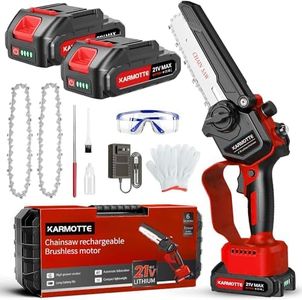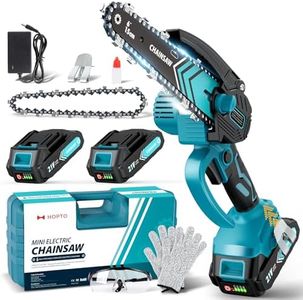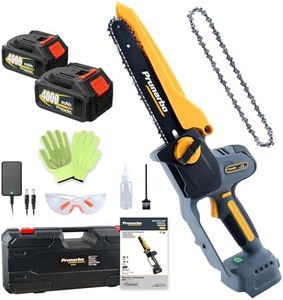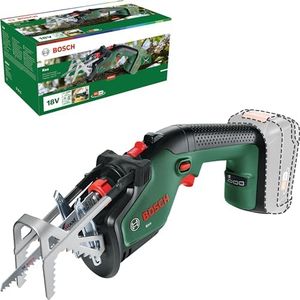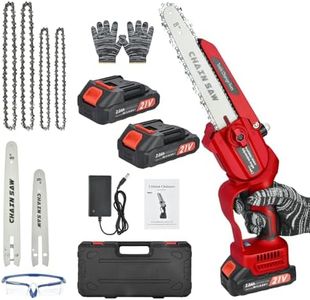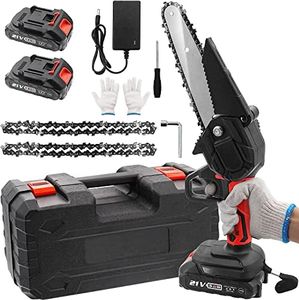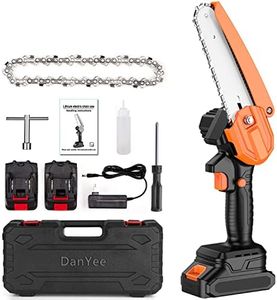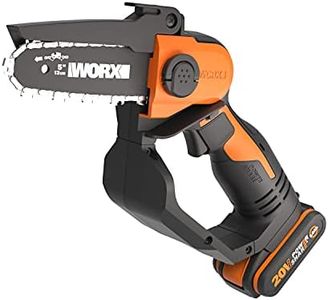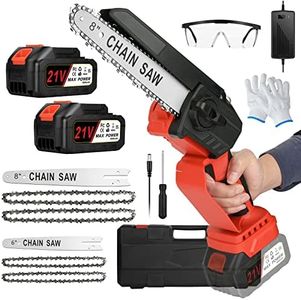We Use CookiesWe use cookies to enhance the security, performance,
functionality and for analytical and promotional activities. By continuing to browse this site you
are agreeing to our privacy policy
10 Best Mini Chainsaw
From leading brands and best sellers available on the web.By clicking on a link to a third party's website, log data is shared with that third party.
Buying Guide for the Best Mini Chainsaw
Choosing a mini-chainsaw is all about matching the tool to your needs, whether you’ll be trimming branches, prepping firewood, or tackling small woodworking projects. Because mini-chainsaws are compact, lightweight, and easy to handle, they’re especially useful for jobs where maneuverability and ease of use matter more than raw power. The key is to consider how you’ll use the saw most of the time, pay close attention to the primary specifications, and ensure that the model you pick lines up with your expectations on both performance and comfort.Bar LengthBar length is the length of the cutting blade, and it determines the maximum diameter of wood the chainsaw can cut in one pass. Shorter bars, around 4 to 6 inches, make the saw lighter and easier to control, especially in tight spaces or for precise cuts. These are great for pruning and trimming tasks. A slightly longer bar, say 7 inches or more, allows for cutting thicker branches or small logs but may make the tool heavier and a bit harder to handle, especially overhead. Think about the tasks you’ll do most often—if you'll mostly be doing light work, a shorter bar is ideal; if you need to handle slightly larger branches, a longer bar can be helpful.
Power SourceMini-chainsaws can be powered by batteries or plugged into an outlet, and this affects where and how long you can use them. Cordless (battery-powered) models offer freedom of movement and are excellent for outdoor use far from a power source, but they do depend on the battery’s run time. Corded electric models provide unlimited operation time but tie you to an extension cord and a power socket, which can limit mobility. If you need maximum portability or expect to work away from home, cordless models are usually better; if you won’t stray too far from an outlet and want uninterrupted cutting time, a corded version might suit you.
Battery Capacity (if cordless)Battery capacity, measured in amp-hours (Ah) or watt-hours (Wh), tells you how long the chainsaw can run on a single charge. Higher capacity means longer work sessions between charges, but it can also add weight to the tool. For small, occasional jobs or light yard work, a lower capacity battery might be fine because you won’t need long sessions. For regular use or bigger projects, a higher capacity battery will keep you working longer without interruption. It’s important to estimate how much run time you’ll actually need and match the battery accordingly.
Chain SpeedChain speed is how fast the cutting chain moves along the bar, usually given in meters per second or feet per second. A faster chain can cut through wood more quickly and smoothly, which makes work faster and reduces the effort required. Lower speeds are adequate for light duty or precise work, while higher speeds help when cutting thicker or tougher material. Consider what you’ll be cutting; if it’s just small branches or softwood, lower chain speed works, but for higher efficiency with harder or larger wood, higher chain speed is advantageous.
WeightWeight matters because mini-chainsaws are often used one-handed, sometimes at awkward angles or overhead. Lighter saws are easier to handle and less tiring to use for extended periods, but extremely lightweight models may afford less stability or power. If you know you’ll be working in the yard for a while, especially above shoulder level, prioritize a saw that’s light and well-balanced for you. If you’re comfortable managing a bit more heft, you can go for a slightly heavier model that might have more power or features.
Safety FeaturesSafety features, such as chain guards, safety locks, and anti-kickback mechanisms, help protect you during operation. These features prevent accidental starting, help reduce the risk of injury if the saw kicks back, and generally make the tool safer, especially for beginners. If you’re new to chainsaws or will be working in challenging positions, look for a tool with clear, easy-to-use safety features to give you peace of mind.
